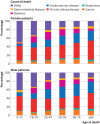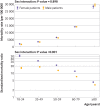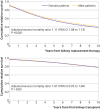Sex differences in mortality among binational cohort of people with chronic kidney disease: population based data linkage study
- PMID: 34785509
- PMCID: PMC8593820
- DOI: 10.1136/BMJ-2021-068247
Sex differences in mortality among binational cohort of people with chronic kidney disease: population based data linkage study
Abstract
Objective: To evaluate sex differences in mortality among people with kidney failure compared with the general population.
Design: Population based cohort study using data linkage.
Setting: The Australian and New Zealand Dialysis and Transplant Registry (ANZDATA), which includes all patients receiving kidney replacement therapy in Australia (1980-2019) and New Zealand (1988-2019). Data were linked to national death registers to determine deaths and their causes, with additional details obtained from ANZDATA.
Participants: Of 82 844 people with kidney failure, 33 329 were female (40%) and 49 555 were male (60%); 49 376 deaths (20 099 in female patients; 29 277 in male patients) were recorded over a total of 536 602 person years of follow-up.
Main outcome measures: Relative measures of survival, including standardised mortality ratios, relative survival, and years of life lost, using general population data to account for background mortality (adjusting for country, age, sex, and year). Estimates were stratified by dialysis modality (haemodialysis or peritoneal dialysis) and for the subpopulation of kidney transplant recipients.
Results: Few differences in outcomes were found between male and female patients with kidney failure. However, compared with the general population, female patients with kidney failure had greater excess all cause deaths than male patients (female patients: standardised mortality ratio 11.3, 95% confidence interval 11.2 to 11.5, expected deaths 1781, observed deaths 20 099; male patients: 6.9, 6.8 to 6.9, expected deaths 4272, observed deaths 29 277). The greatest difference was observed among younger patients and those who died from cardiovascular disease. Relative survival was also consistently lower in female patients, with adjusted excess mortality 11% higher (95% confidence interval 8% to 13%). Average years of life lost was 3.6 years (95% confidence interval 3.6 to 3.7) greater in female patients with kidney failure compared with male patients across all ages. No major differences were found in mortality by sex for haemodialysis or peritoneal dialysis. Kidney transplantation reduced but did not entirely remove the sex difference in excess mortality, with similar relative survival (P=0.83) and years of life lost difference reduced to 2.3 years (95% confidence interval 2.2 to 2.3) between female and male patients.
Conclusions: Compared with the general population, female patients had greater excess deaths, worse relative survival, and more years of life lost than male patients, however kidney transplantation reduced these differences. Future research should investigate whether systematic differences exist in access to care and possible strategies to mitigate excess mortality among female patients.
© Author(s) (or their employer(s)) 2019. Re-use permitted under CC BY-NC. No commercial re-use. See rights and permissions. Published by BMJ.
Conflict of interest statement
Competing interests: All authors have completed the ICMJE uniform disclosure form at www.icmje.org/disclosure-of-interest/ and declare: support from Kidney Health Australia for the linked data used in the submitted work; no financial relationships with any organisations that might have an interest in the submitted work in the previous three years; no other relationships or activities that could appear to have influenced the submitted work.
Figures






Similar articles
-
[The Veneto Region's Registry of Dialysis and Transplantation: 2006-2007 report].G Ital Nefrol. 2009 Nov-Dec;26 Suppl 48:S5-56. G Ital Nefrol. 2009. PMID: 19927265 Italian.
-
Relative survival in patients with cancer and kidney failure.Nephrol Dial Transplant. 2024 Sep 27;39(10):1604-1612. doi: 10.1093/ndt/gfae046. Nephrol Dial Transplant. 2024. PMID: 38383906
-
Life Years Lost in Children with Kidney Failure: A Binational Cohort Study with Multistate Probabilities of Death and Life Expectancy.J Am Soc Nephrol. 2023 Jun 1;34(6):1057-1068. doi: 10.1681/ASN.0000000000000118. Epub 2023 Apr 7. J Am Soc Nephrol. 2023. PMID: 36918386 Free PMC article.
-
Employment of patients with kidney failure treated with dialysis or kidney transplantation-a systematic review and meta-analysis.BMC Nephrol. 2021 Oct 22;22(1):348. doi: 10.1186/s12882-021-02552-2. BMC Nephrol. 2021. PMID: 34686138 Free PMC article.
-
Systematic review: kidney transplantation compared with dialysis in clinically relevant outcomes.Am J Transplant. 2011 Oct;11(10):2093-109. doi: 10.1111/j.1600-6143.2011.03686.x. Epub 2011 Aug 30. Am J Transplant. 2011. PMID: 21883901
Cited by
-
Cost-effectiveness of Interventions to Increase Utilization of Kidneys From Deceased Donors With Primary Brain Malignancy in an Australian Setting.Transplant Direct. 2023 Apr 19;9(5):e1474. doi: 10.1097/TXD.0000000000001474. eCollection 2023 May. Transplant Direct. 2023. PMID: 37090124 Free PMC article.
-
Sex Differences in Excess Mortality Among Waitlisted Kidney, Heart, and Liver Transplant Candidates.Transplant Direct. 2025 Aug 22;11(9):e1856. doi: 10.1097/TXD.0000000000001856. eCollection 2025 Sep. Transplant Direct. 2025. PMID: 40862214 Free PMC article.
-
Twenty-Year Mortality Trends in Patients with Kidney Disease in Poland with the Use of the Years of Life Lost Measure, 2000-2019.Int J Environ Res Public Health. 2022 Feb 24;19(5):2649. doi: 10.3390/ijerph19052649. Int J Environ Res Public Health. 2022. PMID: 35270338 Free PMC article.
-
Sex disparities in mortality and cardiovascular outcomes in chronic kidney disease.Clin Kidney J. 2024 Feb 21;17(3):sfae044. doi: 10.1093/ckj/sfae044. eCollection 2024 Mar. Clin Kidney J. 2024. PMID: 38638550 Free PMC article. Review.
-
Dialysis and the risk of early urological cancer: A nationwide population-based cohort study in Taiwan.Medicine (Baltimore). 2025 May 16;104(20):e42521. doi: 10.1097/MD.0000000000042521. Medicine (Baltimore). 2025. PMID: 40388720 Free PMC article.
References
Publication types
MeSH terms
LinkOut - more resources
Full Text Sources
